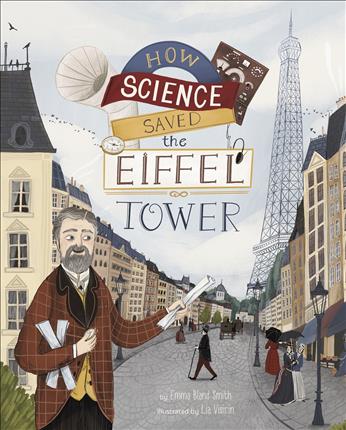| How science saved the Eiffel tower Author: Smith, Emma Bland | ||
| Price: $22.58 | ||
Summary:
The city of Paris wanted to tear down the Eiffel Tower Gustave Eiffel built for the1889 World's Fair. More than a million delighted people flocked to visit it during the fair. But the officials wondered, beyond being a spectacle, what is it good for? It must come down! But Eiffel loved his tower. He crafted a clever plan to make the tower too useful to tear down by turning it into "a laboratory such as science has never had at its disposal." Could science save the Eiffel Tower?
| Illustrator: | Visirin, Lia |
| Accelerated Reader Information: Interest Level: MG Reading Level: 4.80 Points: .5 Quiz: 516869 |
Reviews:
School Library Journal (08/26/22)
Booklist (+) (07/01/22)
Full Text Reviews:
School Library Journal - 08/26/2022 Gr 2–4—When the Eiffel Tower was first erected for the 1889 World's Fair, the citizens of Paris hated it. Only after construction was complete did they embrace its unique structure. However, the agreement with the city officials was to tear the tower down after 20 years. To keep his creation standing, architect Gustave Eiffel scrambled to make the tower practically useful. He installed a modern weather station at the top. He used it to help measure the physics of wind to figure out the aerodynamics of air travel. He even made it into a radio-transmitting tower. Once people accepted it as both architecturally unique and useful, they decided to keep it. The book's text clearly conveys the complex attitudes at the time. Illustrations do a wonderful job depicting 19th-century Paris. The tower is exquisitely rendered in all phases of construction, and so are the bickering citizens of Paris. Visirin's artwork is reminiscent of David Roberts's intricate linework. VERDICT Add to large nonfiction collections in need of unique perspectives on world landmarks.—Chance Lee Joyner - Copyright 2022 Publishers Weekly, Library Journal and/or School Library Journal used with permission.
Booklist - 07/01/2022 *Starred Review* Engineer Gustave Eiffel designed, financed, and oversaw the construction of the iron-latticework tower that marked the entrance to the 1889 world’s fair in Paris. Though Parisians scoffed at the unusual structure before its completion, both residents and visitors soon shared its creator’s love for the distinctive Eiffel Tower. Disturbed that officials would allow it to stand for only 20 years, Eiffel searched for ways to save the landmark by making it invaluable. First, he equipped it with an advanced weather station. Next, he added a wind tunnel for testing airplane parts. Finally, a wireless broadcasting facility on the tower made it indispensable to the French military. Combining a practical approach with ingenuity and persistence, Eiffel had saved his iconic tower for future generations. The engaging narrative builds tension as Eiffel attacks the problem of saving his tower as he would an engineering challenge, trying one approach after another until finally, cleverly, he succeeds. With varied compositions and a rich yet subtle palette, the illustrations work seamlessly with the text, while portraying the man within a beautiful period setting. One of the few picture-book biographies celebrating the work of an engineer, this volume tells the little-known story of a man who left his mark upon the world. - Copyright 2022 Booklist.
Booklist - 07/01/2022 - Copyright 2022 Booklist.



